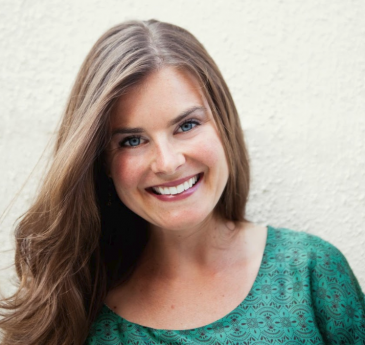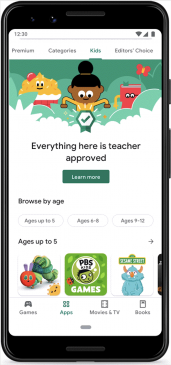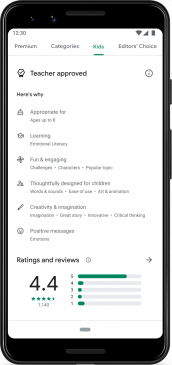Mindy Brooks is the Director of UX for Google Play, and one of the key masterminds around the creation of a new Kids section that features Teacher Approved apps on Google Play. Her kids and family team focuses on designing technology that meets the needs of families around the world and helps other teams understand developmental principles for families that help drive product design and vision. Mindy is also an alumna of Sesame Workshop, where she was Director of Content & Research. We were thrilled to have the opportunity to catch up and learn more about this new initiative came together.
 The new “Teacher Approved” section of the Google Play Store is an ambitious effort to help families find highly-rated apps for kids. We’d love to hear more about how it came together.
The new “Teacher Approved” section of the Google Play Store is an ambitious effort to help families find highly-rated apps for kids. We’d love to hear more about how it came together.
In April, we launched a new section in the Google Play Store labeled “Kids,” where teacher-reviewed and rated apps are located. Building off of the work we have already done for Families in the Play Store, we are going a step further to make sure that every single app in the newly launched Kids tab has been reviewed and rated by teachers.
The ratings are based on a rubric developed in consultation with a group of expert advisors led by Joe Blatt from the Harvard Graduate School of Education and Dr. Sandra Calvert from Georgetown University. We then recruited teachers from across the U.S. to rate each app using this rubric. Parents can now see experts’ ratings for each app, providing them with an easy way to find vetted and age-appropriate content for their children. It caters to three age groups: 0-5, 6-8, and 9-12 years old.
 Why was it so important to you to launch Teacher Approved content on Google Play?
Why was it so important to you to launch Teacher Approved content on Google Play?
One thing we take very seriously is listening to our users—and in this situation, it’s parents. We’ve heard for years from parents around the world that it’s really difficult to identify high-quality content for children among the vast array of offerings. In order to locate the great apps that are out there, parents have had to do a lot of the heavy lifting to find quality content that fits their child’s needs. It was important to me, as someone with an education and child development background, to ensure that the largest app store in the world contained a separate section with clear badging that was deemed high quality by trustworthy experts—teachers.
The importance of this launch was underscored by its timing. We had been working on this program for over three years. As you can imagine, developing the rubrics, hiring hundreds of teachers, and then having them review the thousands of kids’ apps we have in the Play Store takes a long time. The original launch date had been forthis summer, but with the lockdown, we found that parents were asking more than ever for help finding high-quality apps for their kids. So we did what only a company with the scale and resources of Google can do, and pushed up the entire launch by two months so we can be helpful for parents when they need our help most. We wanted to take the guesswork out of finding high-quality apps on our store right as they were dealing with substantially increased childcare stressors.

How do you define high-quality? What are teachers looking for when they review apps?
Great question. Over the past few years, we’ve worked extensively with our advisors to develop a framework for rating apps for kids. This was a multi-phased approach in which we refined, piloted, and refined some more. The result is a framework that includes design quality, appeal, enrichment potential, and content appropriateness based on age. Not all content needs to be educational, but it does need to support a child’s healthy development. And of course, as should be the case for any kids’ apps, we looked for delight!
Why human curation? Could this be done by technology?
We believe it’s important that when developing frameworks for rating content, we lean on experts themselves to tell us what is good. In this situation, our experts are teachers. We believe they have the child development expertise and intuition to identify what is good for kids.
It’s U.S.-based now—do you have plans for expansion?
Yes! We are currently working on the global expansion of the program. When we began developing our framework for rating apps, it was critical that we vet our rubrics globally to ensure relevance in other regions of the world. We worked with our public policy colleagues at Google in 18 countries throughout Latin America, Asia-Pacific, the Middle East, North Africa, and across mainland Europe and the UK to make sure that the rubrics were universal in their applicability. We developed a foundation for ratings based on a global child development framework.
What kind of support are you offering the developers of kids’ content who are impacted by this program?
Our developers have been top of mind as we developed this framework. We’ve developed detailed training materials and learning modules for kids developers. And in three years of developing these rubrics and reviewing thousands upon thousands of kids’ apps, we’ve gained a lot of insight into what it takes to develop great apps for kids. So we took all those learning and just recently launched design guidelines for creating content for kids based on them.
What’s next for kids at Google?
Google wants to be as helpful as it can be to the whole family, and kids are no exception! There are a lot of different initiatives underway that focus on helping children and parents get the most out of technology. We want to bring this content and these tools to children all over the world. Stay tuned throughout the year!

